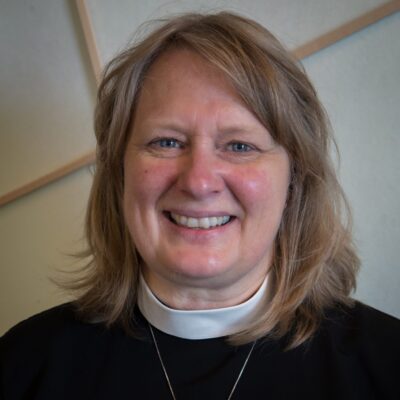This sermon was inspired by the work of theologian Shelly Rambo in her book Resurrecting Wounds.
Once upon a time, in a small French alpine village, strange incidences occurred: people who were once dead, were alive again. They made their way to their old homes, looking for the people that should be there, seemingly whole and confused by how time had continued on without them.
One of ‘The Returned’, as they were called, was a teenage girl named Camille, who had died four years previous in a bus accident on a school trip. She comes home like it is any other day, with no memory of her death. Her mother, Claire, calls her estranged husband, Jerome, while he is at a grief group, to tell him that Camille is standing in the kitchen. Jerome thinks Claire has really gone off the rails and leaves to go check on her, confronting the strange truth for himself: Camille is alive and no one knows why, including Camille.
At the grief group, a pregnant woman, Sandrine, tells the circle that she is reluctant to make the pregnancy announcement after the loss of her other child—presumably in the same bus accident as they go on to discuss the memorial being unveiled to commemorate the village’s collective loss. Sandrine reflects, “Perhaps we don’t get over the loss, but life continuer, advancer. Life always prevails.”
As time goes on, others of Les Revenants – The Returned (also the name of the show in English) are revealed—from different time periods, different ages, and different ideas as to why they came back. Thomas, a police detective, has an especially vested interest in The Returned because his fiancée, Adele’s, former fiancé, Simon, is one of them. Adele’s daughter, Chloe, is Simon’s child. Talk about complicated!
Thomas, representing logic and pragmatism, goes to their local Roman Catholic church to talk to the priest in order to understand a seemingly supernatural occurrence. The priest does not take Simon’s appearance seriously, telling Thomas that he is just a ghost—a figment of a grief-stricken woman who is about to marry someone else. But Thomas questions the priest. “Wasn’t Jesus considered a ghost when he came back?” The priest is puzzled and asks him why he would ask that. Thomas replies, “He [Simon] was here. Physically speaking. In flesh and blood.” The priest tries to dissuade Thomas from taking the story of Jesus appearing after resurrection so literally, but Thomas will not be put off, eventually asking the priest if he believes in Jesus’ resurrection. The priest says, “Of course,” and Thomas continues to press him in order to understand why Simon is here, appearing now after death. The priest tells him, “Believing is more important than seeing.” Thomas asks more questions, and the priest, getting irritated, exclaims, “You don’t ask the right questions,” to which Thomas replies, “You don’t give the right answers” and leaves the church.
This contemporary Thomas wants to understand the ongoingness of life, as theologian and Associate Professor at Boston University Shelly Rambo calls it, in the midst of death and Jesus is the only example he has to question.
“The use of the term ‘trauma’ to name the pathos and pathologies of American culture should be approached critically, but it is also important to ask why it has taken hold,” Shelly Rambo writes in her book Resurrecting Wounds. She goes on to say, “Images in popular culture of the dead returning and of wounds resurfacing are worthy of our attention. These depictions as well as those within popular novels and films accompany theories of trauma and can serve not only to figure violence and its effects but also potentially alternative approaches to it” (pg. 4).
Jesus, returning from extreme trauma—mental, emotional, and physical—resulting in death, with his wounds visible and not hidden, gives us a way of engaging in relationship to and responsibility for the past as something that remains. We do not move beyond or into something more than this suffering without encompassing it as the ongoingness of death in life. Like Camille and Simon returning to their village, what does it mean that Jesus returns bearing the marks of death into life?
In The Returned, Camille has a twin sister who continued to age and grow up while Camille was dead. At first, Camille does not have any visible wounds, but her presence brings to light other traumas, other woundings in those around her, eventually causing Lena to have physical manifestations of Camille’s trauma. There is a symbiosis of the wounds coming to the surface, binding together the living and the dead. The impact of violence creates trauma that carries into the present, and resurrection invites us to weave together a new way of being in life that allows for the ongoingness of life in death and death in life as seen in Camille and Lena.
Jesus invites Thomas the disciple to “[p]ut your finger here and see my hands. Reach out your hand and put it in my side.” We do not know if the wounds were fresh or if they were scars, or if Thomas actually touches them, but it is clear they were visible and embodied from this exchange. Artists have imagined various scenarios, but we are not given this information. Regardless, Jesus is asking for Thomas to witness the trauma that happened to him and to understand the responsibility of this witness. When the French police detective Thomas is interrogating the priest about the resurrection, he asks him, “Is it for good or not?” The priest responds, “The question is irrelevant.” Get a better priest! Thomas is desperate to know if the resurrection can speak meaningfully to what is happening in their lives in that moment, not an abstract belief. Is resurrection good? Does it bring about goodness? Can bearing witness to unbearable wounds bring about something good?
The question of what happens when we live through and come back from a traumatic experience permeates our modern life. Veterans, abuse survivors, LGBTQ+, BIPOC folx, refugees, and others who have endured violence in this world stand with the wounded and resurrected Jesus asking the wider community to witness what has happened. Our wounds cannot always be easily seen or accessed, as they surface and recede in the ongoingness of life after trauma. Pain that is not transformed is transmitted and it is vital that the community bear witness to the stories that the wounds represent, just as the disciples, and especially Thomas, did in that Upper Room. In bearing witness, the wounds are no longer separated or forgotten from the enfleshed experience and a new relationship is formed.
How then, do we heal? What do we do with the wounds? In our Eucharistic Prayer C we proclaim together, “By his wounds, we are healed.” Jesus appeared to the disciples in the Upper Room with his wounds saying, “Peace be with you. As the Father has sent me, so I send you.” God has sent Jesus to them—to us—with his wounds in the ongoingness of life after trauma and death. Jesus is sending the disciples and us out with our wounds as God has sent him. But first, they must receive the peace that passes all understanding that makes peace with the dead and the living. Jesus breathes on them to give them the Holy Spirit—to create a different way of being in community than before. Jesus’ appearance in the Upper Room is tied to his previous healing work. He is there amongst them, seeking out what was lost like a lamb who has strayed from the shepherd. Notice that he doesn’t come to Thomas while by himself, but comes to the disciples gathered together as they are grieving and processing their own traumas surrounding his death in community.
Alfred Adler, a 20th century psychotherapist contemporary of Sigmund Freud and Carl Jung, believed that there was no mental health without being part of community. We cannot heal alone. We must have a circle of witness to our wounds, in order to transform our pain instead of transmitting it. Jesus was the first example of this. Notice that he did not come to the disciples here in our story or in any of his visitations (that we know of) with guns a’blazin’ and ready to commit acts of violence on those who gave him his wounds, those who abandoned him in his greatest need, and anyone who got in his way. Instead, he stands before them, with his wounds, asking Thomas and the others to bear witness. Jesus’ losses are held by his community, and, in bearing witness, they must also dedicate themselves to their own work. Because now, Spirit lives in them and in doing so helps them carry the difficult truths of Jesus’ story and their own.
This is what we are asked to do today. How does this community work through loss to carry forward Jesus’ message? Jesus is the Wound Bearer and yet, he is whole. He appears amidst us with his peace, and his presence demands that we respond to our own woundedness, not just individually, but collectively. The Upper Room was a place where wounds were revealed and grief, anger, and pain were released. Is that not how our faithful communities of discipleship should be? But Jesus does not want us to stay there. He gives us the Holy Spirit to go out and share his message and embody-ness of what it means to live in the ongoingness of death. Resurrection requires re-membering in a way that has not been before Jesus’ presence in that Upper Room. “By his wounds we are healed” involves each of us bearing witness to one another’s stories, holding them as they are transformed into sacredness.
A Jesuit priest I know used to sign off all his correspondence with “Practice resurrection daily.” What a message and reminder. “Is [resurrection] good?” Thomas the French police detective asks. We can only know this as we live the answer, together. AMEN.







